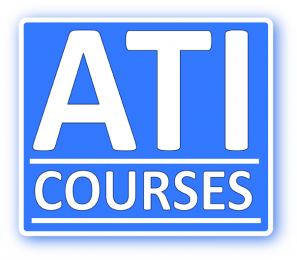ATI Earth Station Design, Implementation, Operation and Maintenance for Satellite Communications Course
Summary:
This intensive four-day course is intended for satellite communications engineers, earth station design professionals, and operations and maintenance managers and technical staff. The course provides a proven approach to the design of modern earth stations, from the system level down to the critical elements that determine the performance and reliability of the facility. We address the essential technical properties in the baseband and RF, and delve deeply into the block diagram, budgets and specification of earth stations and hubs. Also addressed are practical approaches for the procurement and implementation of the facility, as well as proper practices for O&M and testing throughout the useful life. The overall methodology assures that the earth station meets its requirements in a cost effective and manageable manner. Each student will receive a copy of Bruce R. Elbert’s textThe Satellite Communication Ground Segment and Earth Station Engineering Handbook, Artech House, 2001.
- Ground Segment and Earth Station Technical Aspects
Evolution of satellite communication earth stations—teleports and hubs
Earth station design philosophy for performance and operational effectiveness
Engineering principles- Propagation considerations: the isotropic source, line of sight, antenna principles
- Atmospheric effects: troposphere (clear air and rain) and ionosphere (Faraday and scintillation)
- Rain effects and rainfall regions; use of the DAH and Crane rain models
- Modulation systems (QPSK, OQPSK, MSK, GMSK, 8PSK, 16 QAM, and 32 APSK)
- Forward error correction techniques (Viterbi, Reed-Solomon, Turbo, and LDPC codes)
- Transmission equation and its relationship to the link budget
-
Radio frequency clearance and interference consideration
- RFI prediction techniques
- Antenna sidelobes (ITU-R Rec 732)
- Interference criteria and coordination
- Site selection
- RFI problem identification and resolution
- Major Earth Station Engineering
RF terminal design and optimization
- Antennas for major earth stations (fixed and tracking, LP and CP)
- Upconverter and HPA chain (SSPA, TWTA, and KPA)
- LNA/LNB and downconverter chain
- Optimization of RF terminal configuration and performance (redundancy, power combining, and safety)
Baseband equipment configuration and integration
Designing and verifying the terrestrial interface
Station monitor and control
Facility design and implementation- Prime power and UPS systems
- Developing environmental requirements (HVAC)
- Building design and construction
- Hub Requirements and Supply
Earth station uplink and downlink gain budgets
- EIRP budget
- Uplink gain budget and equipment requirements
- G/T budget
- Downlink gain budget
- Equipment and system specifications
- Format of a Request for Information
- Format of a Request for Proposal
- Technical comparison criteria
- Operational requirements Cost-benefit and total cost of ownership
Course Outline:
Speaker and Presenter Information
Bruce R. Elbert, MSc (EE), MBA, Adjunct Professor, College of Engineering, University of Wisconsin, Madison. Mr. Elbert is a recognized satellite communications expert and has been involved in the satellite and telecommunications industries for over 30 years. He founded ATSI to assist major private and public sector organizations that develop and operate cutting-edge networks using satellite technologies and services. During 25 years with Hughes Electronics, he directed the design of several major satellite projects, including Palapa A, Indonesia’s original satellite system; the Galaxy follow-on system (the largest and most successful satellite TV system in the world); and the development of the first GEO mobile satellite system capable of serving handheld user terminals. Mr. Elbert was also ground segment manager for the Hughes system, which included eight teleports and 3 VSAT hubs. He served in the US Army Signal Corps as a radio communications officer and instructor. By considering the technical, business, and operational aspects of satellite systems, Mr. Elbert has contributed to the operational and economic success of leading organizations in the field. He has written nine books on telecommunications and IT, including Introduction to Satellite Communication, Third Edition (Artech House, 2008).The Satellite Communication Applications Handbook, Second Edition (Artech House, 2004); The Satellite Communication Ground Segment and Earth Station Handbook (Artech House, 2001), the course text.Relevant Government Agencies
Air Force, Army, Intelligence Agencies, DOD & Military, NASA, Other Federal Agencies, CIA, National Institutes of Health
This event has no exhibitor/sponsor opportunities
When
Mon, Feb 28 - Thu, Mar 3, 2011, 8:30am - 4:30pm
Where
Colorado Springs, CO
Website
Click here to visit event website
Organizer
ATI Courses







